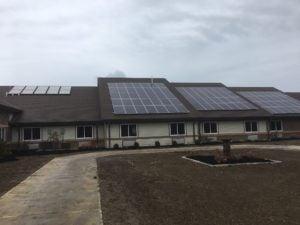Project demonstrates how PACE financing works to grow solar in Ohio

 Residents of the Tipp City Livingston Health Care & Rehabilitation Center will soon have their facility powered by solar. The 150 kW system, installed by Energy Optimizers, USA, is forecast to provide about 20% of the building’s power needs. The project was financed through Property Assessed Clean Energy (PACE) financing.
Residents of the Tipp City Livingston Health Care & Rehabilitation Center will soon have their facility powered by solar. The 150 kW system, installed by Energy Optimizers, USA, is forecast to provide about 20% of the building’s power needs. The project was financed through Property Assessed Clean Energy (PACE) financing.
PACE enables homeowners or commercial building owners to finance energy improvements, like solar, and pay the financing back through an assessment their property taxes. PACE programs connect building owners with capital providers that offer long-term, low-cost financing for energy upgrades.
PACE financing can cover a range of energy projects, from rooftop solar to energy efficiency. The Livingston facility also financed the addition of LED lighting, high efficiency HVAC systems, and better-insulated walls.
 Because financing from PACE is repaid overtime through property taxes, the projects funded through it require no upfront money out of pocket from building owners. Projects financed through PACE can be cash flow positive from day one. This also enables project repayment to be transferrable from one building owner to the next.
Because financing from PACE is repaid overtime through property taxes, the projects funded through it require no upfront money out of pocket from building owners. Projects financed through PACE can be cash flow positive from day one. This also enables project repayment to be transferrable from one building owner to the next.
PACE programs are passed at the state level and administered locally. Ohio enacted PACE in 2009. A unique feature of Ohio’s PACE program is that requires the establishment of an Energy Special Improvement District (ESID) in jurisdictions where PACE-funded projects are located. The ESID is responsible for certifying the proposed PACE projects.
The ESID’s membership is determined by the municipality that creates it. ESID membership is generally composed of local stakeholders such as local officials and the local utility. The approval process to receive PACE funding is typically 60 to 120 days.
